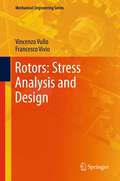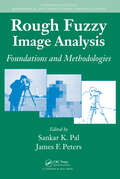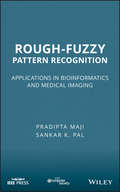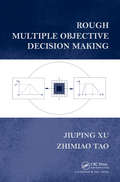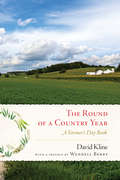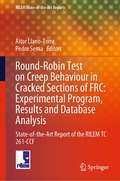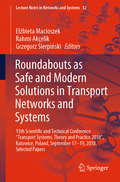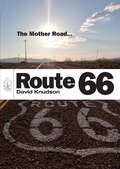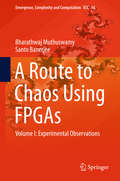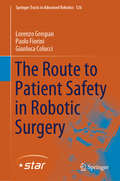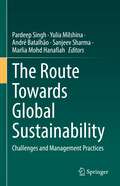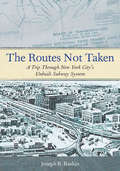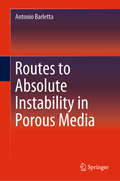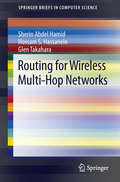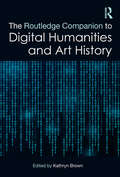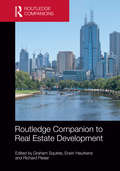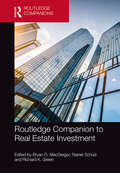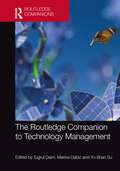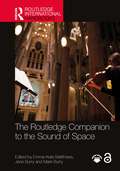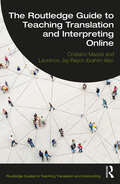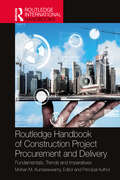- Table View
- List View
Rotors: Stress Analysis and Design
by Vincenzo Vullo Francesco VivioStress and strain analysis of rotors subjected to surface and body loads, as well as to thermal loads deriving from temperature variation along the radius, constitutes a classic subject of machine design. Nevertheless attention is limited to rotor profiles for which governing equations are solvable in closed form. Furthermore very few actual engineering issues may relate to structures for which stress and strain analysis in the linear elastic field and, even more, under non-linear conditions (i.e. plastic or viscoelastic conditions) produces equations to be solved in closed form. Moreover, when a product is still in its design stage, an analytical formulation with closed-form solution is of course simpler and more versatile than numerical methods, and it allows to quickly define a general configuration, which may then be fine-tuned using such numerical methods. In this view, all subjects are based on analytical-methodological approach, and some new solutions in closed form are presented. The analytical formulation of problems is always carried out considering actual engineering applications. Moreover, in order to make the use of analytical models even more friendly at the product design stage, a function is introduced whereby it is possible to define a fourfold infinity of disk profiles, solid or annular, concave or convex, converging or diverging. Such subjects, even derived from scientific authors' contributions, are always aimed at designing rotors at the concept stage, i.e. in what precedes detailed design. Among the many contributions, a special mention is due for the following: linear elastic analysis of conical disks and disks with variable profile along its radius according to a power of a linear function, also subjected to thermal load and with variable density; analysis of a variable-profile disk subjected to centrifugal load beyond the material's yield point, introducing the completely general law expressed by a an n-grade polynomial; linear elastic analysis of hyperbolic disk, subjected to thermal load along its radius; linear elastic analysis of a variable-thickness disk according to a power of a linear function, subjected to angular acceleration; etc.
Rough Fuzzy Image Analysis: Foundations and Methodologies (Chapman & Hall/CRC Mathematical and Computational Imaging Sciences Series)
by Sankar K. Pal James F. PetersFuzzy sets, near sets, and rough sets are useful and important stepping stones in a variety of approaches to image analysis. These three types of sets and their various hybridizations provide powerful frameworks for image analysis. Emphasizing the utility of fuzzy, near, and rough sets in image analysis, Rough Fuzzy Image Analysis: Foundations and
Rough-fuzzy pattern recognition
by Pradipta Maji Sankar K. PalLearn how to apply rough-fuzzy computing techniques to solve problems in bioinformatics and medical image processing Emphasizing applications in bioinformatics and medical image processing, this text offers a clear framework that enables readers to take advantage of the latest rough-fuzzy computing techniques to build working pattern recognition models. The authors explain step by step how to integrate rough sets with fuzzy sets in order to best manage the uncertainties in mining large data sets. Chapters are logically organized according to the major phases of pattern recognition systems development, making it easier to master such tasks as classification, clustering, and feature selection. Rough-Fuzzy Pattern Recognition examines the important underlying theory as well as algorithms and applications, helping readers see the connections between theory and practice. The first chapter provides an introduction to pattern recognition and data mining, including the key challenges of working with high-dimensional, real-life data sets. Next, the authors explore such topics and issues as: Soft computing in pattern recognition and data mining A Mathematical framework for generalized rough sets, incorporating the concept of fuzziness in defining the granules as well as the set Selection of non-redundant and relevant features of real-valued data sets Selection of the minimum set of basis strings with maximum information for amino acid sequence analysis Segmentation of brain MR images for visualization of human tissues Numerous examples and case studies help readers better understand how pattern recognition models are developed and used in practice. This text-covering the latest findings as well as directions for future research-is recommended for both students and practitioners working in systems design, pattern recognition, image analysis, data mining, bioinformatics, soft computing, and computational intelligence.
Rough Multiple Objective Decision Making
by Jiuping Xu Zhimiao TaoUnder intense scrutiny for the last few decades, Multiple Objective Decision Making (MODM) has been useful for dealing with the multiple-criteria decisions and planning problems associated with many important applications in fields including management science, engineering design, and transportation. Rough set theory has also proved to be an effect
Round of a Country Year: A Farmer's Day Book
by David KlineDavid Kline has been called a "twentieth–century Henry David Thoreau" by his friends and contemporaries; an apt comparison given the quiet exuberance with which he records the quotidian goings–on on his organic family farm. Under David's attentive gaze and in his clear, insightful prose the reader is enveloped in the rhythms of farm life; not only the planting and harvesting of crops throughout the year, but the migration patterns of birds, the health and virility of honeybees left nearly to their own devices, the songs and silences of frogs and toads, the disappearance and resurgence of praying mantises in fields–turned woodlands, the search for monarch butterflies in the milkweed. There's rhythm in community, too—neighbors gathering to plant potatoes or to maintain an elderly friend's tomato garden, organic farming conferences and meetings around family dining tables or university panels.Interspersed with local lore (when the spring's first bumblebee appears the children can go barefoot) is deep technical knowledge of cultivation and land management and the hazards of modern agri–business. Kline records statewide meetings of district supervisors, knows which speakers and committee chairmen are in the pockets of the oil and gas lobbyists, stands up and says his part.At a time when America's population is being turned toward the benefits of small, local farming practices on our health and our environment, Kline's daybook offers a striking example of the ways in which we are connected to our environment, and the pleasure we can take in daily work and stewardship.
Round-Robin Test on Creep Behaviour in Cracked Sections of FRC: State-of-the-Art Report of the RILEM TC 261-CCF (RILEM State-of-the-Art Reports #34)
by Aitor Llano-Torre Pedro SernaThe book presents the work of the RILEM Technical Committee 261-CCF, which organized the challenging International Round Robin Test (RRT) on the creep behaviour of Fibre Reinforce Concrete (FRC) cracked specimens. Although different creep test methodologies have been developed in recent years, the absence of a standardised creep methodology hindered general comparisons. Therefore, the RILEM TC 261-CCF launched an ambitious international RRT program to improve the knowledge on long-term behaviour of cracked sections of FRC and assess all the different testing methodologies, assuming the big variability of testing criteria among the scientific community. The participation of 19 laboratories across 20 institutions in 14 countries all over the world enabled the realisation of the largest experimental campaign on creep in the cracked state. As a result of the RRT, an extensive database of creep test results was created containing comprehensive information from 124 cracked FRC specimens tested using different creep testing procedures in agreed conditions. The book will benefit academics and practitioners interested in the long-term behaviour of FRC since it served as basis for the recently published RILEM Recommendation on creep testing procedure and represents the current knowledge on creep in cracked FRC specimens.
Roundabouts as Safe and Modern Solutions in Transport Networks and Systems: 15th Scie15th Scientific And Technical Conference Transport Systems. Theory And Practice 2018 , Katowice, Poland, September 17-19, 2018, Selected Papersntific And Technical Conference Transport Systems. Theory And Practice 2018 Selected Papers (Lecture Notes in Networks and Systems #52)
by Elżbieta Macioszek Grzegorz Sierpiński Rahmi AkçelikThis book offers a collection of guidelines that will be particularly useful to those making decisions concerning roundabouts as safe and modern solutions in transport networks and systems. The decision-making support systems described here will interest those who face the challenge of finding solutions to problems concerning modern transport systems on a daily basis. Consequently, the book is chiefly intended for local authorities involved in planning and preparing development strategies for specific transport-related issues (in both urban and regional contexts), as well as for representatives of business and industry who are directly engaged in the implementation of traffic engineering solutions. The guidelines provided in the respective chapters help to address the given problem soundly, and to simplify the selection of an appropriate strategy. The topics covered include traffic conditions and the performance of single-lane, two-lane and turbo roundabouts, road traffic safety analysis, analysis of road traffic safety improvements, surrogate safety measures at roundabouts, analysis of pedestrian behavior at pedestrian crossings with public transport vehicles, methods for assessing vehicle motion trajectory at single-lane roundabouts using visual techniques, making compact two-lane roundabouts effective for vulnerable road users, concepts for wireless electric vehicle charging near roundabouts, work zones, and temporary traffic control at roundabouts. Since the book also considers new approaches to theoretical models (including modeling roundabout capacity, models of critical gaps and follow-up headways for turbo roundabouts, and estimating roundabout delay while taking into account pedestrian impact), it will also appeal to researchers and scientists studying these problems. The book gathers selected papers presented at the 15th Scientific and Technical Conference “Transport Systems. Theory and Practice”, organized by the Department of Transport Systems and Traffic Engineering, Silesian University of Technology in Katowice, Poland on September 17–19, 2018.
Route 66
by David KnudsonBegun in 1926 to connect Chicago to Los Angeles, Route 66 was the country's first major east-west thoroughfare. By 1930 it was an important route for both truckers and travellers alike, and in 1939 it became known as 'The Mother Road' thanks to John Steinbeck's classic "The Grapes of Wrath". Over the years, hundreds of thousands of Americans travelled this great road - from those heading west during the Great Depression to postwar families taking road trips across the country - but by the 1970s four-lane highways, expressways, and tollways had largely supplanted it, and Route 66 fell into disrepair. In this book, authority David Knudson traces the fascinating story of The Mother Road from origins to decline, including the roadside attractions and cottage industries it spawned and the efforts to save and restore it.
A Route to Chaos Using FPGAs: Volume I: Experimental Observations (Emergence, Complexity and Computation #16)
by Santo Banerjee Bharathwaj MuthuswamyThe purpose of this introductory book is to couple the teaching of chaotic circuit and systems theory with the use of field programmable gate arrays (FPGAs). As such, it differs from other texts on chaos: first, it puts emphasis on combining theoretical methods, simulation tools and physical realization to help the reader gain an intuitive understanding of the properties of chaotic systems. Second, the "medium" used for physical realization is the FPGA. These devices are massively parallel architectures that can be configured to realize a variety of logic functions. Hence, FPGAs can be configured to emulate systems of differential equations. Nevertheless maximizing the capabilities of an FPGA requires the user to understand the underlying hardware and also FPGA design software. This is achieved by the third distinctive feature of this book: a lab component in each chapter. Here, readers are asked to experiment with computer simulations and FPGA designs, to further their understanding of concepts covered in the book. This text is intended for graduate students in science and engineering interested in exploring implementation of nonlinear dynamical (chaotic) systems on FPGAs.
The Route to Patient Safety in Robotic Surgery (Springer Proceedings in Advanced Robotics #126)
by Lorenzo Grespan Paolo Fiorini Gianluca ColucciThe introduction of a new technology in a consolidated field has the potential to disrupt usual practices and create a fertile ground for errors. An example is robotic surgery that is now used in most surgical specialties, pushed by technology developers and enthusiastic surgeons. To analyze the potential impact of robotic surgery on patient safety, a consortium of major European Universities started the project SAFROS whose findings are summarized and further elaborated in the three parts of this book. Part one describes safety in complex systems such as surgery, how this may disrupt the traditional surgical workflow, how safety can be monitored, and the research questions that must be posed. Part two of the book describes the main findings of this research, by identifying the risks of robotic surgery and by describing where its ancillary technologies may fail. This part addresses features and evaluation of anatomic imaging and modeling, actions in the operating room, robot monitoring and control, operator interface, and surgical training. Part three of the book draws the conclusions and offers suggestions on how to limit the risks of medical errors. One possible approach is to use automation to monitor and execute parts of an intervention, thus suggesting that robotics and artificial intelligence will be major elements of the operating room of the future.
The Route Towards Global Sustainability: Challenges and Management Practices
by Pardeep Singh Yulia Milshina André Batalhão Sanjeev Sharma Marlia Mohd HanafiahThis volume discusses topics of global sustainability involving sustainability indicators, stakeholders' participation, and technological and strategic advances with the goal of "thinking locally to act globally". Scientists, academics, policymakers, and planners are currently focused on escalating global socioeconomic and ecological issues, such as rising inequality, adverse anthropogenic impacts on the environment, and deficiencies in natural resources. These variables are pushing the earth system's resistance capacity past its breaking point, with additional pressures incurred by a global pandemic. Therefore, this book looks to impart knowledge on participatory learning action research for human and environmental health and well-being. Sustainable development planning and management are needed in these pressing circumstances, and they necessitate an analytical interpretation of ongoing processes, current and future challenges, and an understanding of available tools and technologies. The main sections of the book focus on challenges and management practices for global sustainability, promoting educational values, smart initiatives in urban contexts, and integrating emerging sustainability dimensions in policies and legislation. The primary audience for the work is policy makers, urban planners, social scientists, economists, NGOs, and students, researchers, and educators engaged in environmental social science and sustainability management.
The Routes Not Taken: A Trip Through New York City's Unbuilt Subway System
by Joseph B. RaskinA fascinating journey into the past—and under the ground—that offers &“an insightful look at the what-might-have-beens of urban mass transit&” (The New York Times). From the day it broke ground by City Hall in 1900, it took about four and half years to build New York&’s first subway line to West 145th Street in Harlem. Things rarely went that quickly ever again. The Routes Not Taken explores the often-dramatic stories behind unbuilt or unfinished subway lines. The city&’s efforts to expand its underground labyrinth were often met with unexpected obstacles—financial shortfalls, clashing political agendas, battles with community groups, and more. After discovering a copy of the 1929 subway expansion map, Joseph B. Raskin began his own investigation into the city&’s underbelly. Here he provides an extensively researched history of the Big Apple&’s unfinished business. The Routes Not Taken sheds light on: *the efforts to expand the Hudson Tubes into a full-fledged subway *the Flushing line, and why it never made it past Flushing *a platform under Brooklyn&’s Nevins Street station unused for more than a century *the 2nd Avenue line—long the symbol of dashed dreams—deferred countless times since the original plans were presented in 1929 Raskin reveals the personalities involved, explaining why Fiorello H. La Guardia couldn&’t grasp the importance of subway lines and why Robert Moses found them old and boring. By focusing on unbuilt lines, he illustrates how the existing system is actually a Herculean feat of countless compromises. Filled with illustrations, this is an enduring contribution to the history of transportation and the history of New York City.
Routes of Power
by Christopher F. JonesThe fossil fuel revolution is usually rendered as a tale of historic advances in energy production. In this perspective-changing account, Christopher F. Jones instead tells a story of advances in energy access--canals, pipelines, and wires that delivered power in unprecedented quantities to cities and factories at a great distance from production sites. He shows that in the American mid-Atlantic region between 1820 and 1930, the construction of elaborate transportation networks for coal, oil, and electricity unlocked remarkable urban and industrial growth along the eastern seaboard. But this new transportation infrastructure did not simply satisfy existing consumer demand--it also whetted an appetite for more abundant and cheaper energy, setting the nation on a path toward fossil fuel dependence. Between the War of 1812 and the Great Depression, low-cost energy supplied to cities through a burgeoning delivery system allowed factory workers to mass-produce goods on a scale previously unimagined. It also allowed people and products to be whisked up and down the East Coast at speeds unattainable in a country dependent on wood, water, and muscle. But an energy-intensive America did not benefit all its citizens equally. It provided cheap energy to some but not others; it channeled profits to financiers rather than laborers; and it concentrated environmental harms in rural areas rather than cities. Today, those who wish to pioneer a more sustainable and egalitarian energy order can learn valuable lessons from this history of the nation's first steps toward dependence on fossil fuels.
Routes to Absolute Instability in Porous Media
by Antonio BarlettaThis book addresses the concepts of unstable flow solutions, convective instability and absolute instability, with reference to simple (or toy) mathematical models, which are mathematically simple despite their purely abstract character. Within this paradigm, the book introduces the basic mathematical tools, Fourier transform, normal modes, wavepackets and their dynamics, before reviewing the fundamental ideas behind the mathematical modelling of fluid flow and heat transfer in porous media. The author goes on to discuss the fundamentals of the Rayleigh-Bénard instability and other thermal instabilities of convective flows in porous media, and then analyses various examples of transition from convective to absolute instability in detail, with an emphasis on the formulation, deduction of the dispersion relation and study of the numerical data regarding the threshold of absolute instability. The clear descriptions of the analytical and numerical methods needed to obtain these parametric threshold data enable readers to apply them in different or more general cases. This book is of interest to postgraduates and researchers in mechanical and thermal engineering, civil engineering, geophysics, applied mathematics, fluid mechanics, and energy technology.
Routine Data Processing in Earthquake Seismology
by Jens Havskov Lars OttemollerThe purpose of this book is to get a practical understanding of the most common processing techniques in earthquake seismology. The book deals with manual methods and computer assisted methods. Each topic will be introduced with the basic theory followed by practical examples and exercises. There are manual exercises entirely based on the printed material of the book, as well as computer exercises based on public domain software. Most exercises are computer based. The software used, as well as all test data are available from http://extras.springer.com. This book is intended for everyone processing earthquake data, both in the observatory routine and in connection with research. Using the exercises, the book can also be used as a basis for university courses in earthquake processing. Since the main emphasis is on processing, the theory will only be dealt with to the extent needed to understand the processing steps, however references will be given to where more extensive explanations can be found. Includes: * Exercises * Test data * Public domain software (SEISAN) available from http://extras.springer.com
Routing for Wireless Multi-Hop Networks
by Hossam S. Hassanein Sherin Abdel Hamid Glen TakaharaThe focus of this brief is to identify what unifies and what distinguishes the routing functions in four wireless multi-hop network paradigms. The brief introduces a generic routing model that can be used as a foundation of wireless multi-hop routing protocol analysis and design. It demonstrates that such model can be adopted by any wireless multi-hop routing protocol. Also presented is a glimpse of the ideal wireless multi-hop routing protocol along with several open issues.
Routing in Opportunistic Networks
by Alagan Anpalagan Isaac Woungang Sanjay Kumar Dhurandher Athanasios V. VasilakosRouting in Opportunistic Networks focuses on the basics of opportunistic networks, modeling and communication in opportunistic networks, routing in opportunistic networks, and collaboration and cooperation in opportunistic networks. The editors will cover such topics as mobility characterization and discovery in opportunistic networks, scheduling and medium access control in opportunistic networks as well as testbed, tools, and measurements for opportunistic networks.
The Routledge Companion to Digital Humanities and Art History (Routledge Art History and Visual Studies Companions)
by Kathryn BrownThe Routledge Companion to Digital Humanities and Art History offers a broad survey of cutting-edge intersections between digital technologies and the study of art history, museum practices, and cultural heritage. The volume focuses not only on new computational tools that have been developed for the study of artworks and their histories but also debates the disciplinary opportunities and challenges that have emerged in response to the use of digital resources and methodologies. Chapters cover a wide range of technical and conceptual themes that define the current state of the field and outline strategies for future development. This book offers a timely perspective on trans-disciplinary developments that are reshaping art historical research, conservation, and teaching. This book will be of interest to scholars in art history, historical theory, method and historiography, and research methods in education.
Routledge Companion to Real Estate Development
by Graham Squires Erwin Heurkens Richard PeiserReal estate development shapes the way people live and work, playing a crucial role in determining our built environment. Around the world, real estate development reflects both universal human needs and region-specific requirements, and with the rise of globalization there is an increasing need to better understand the full complexity of global real estate development. This Companion provides comprehensive coverage of the major contemporary themes and issues in the field of real estate development research. Topics covered include: social and spatial impact markets and economics organization and management finance and investment environment and sustainability design land use policy and governance. A team of international experts across the fields of real estate, planning, geography, economics and architecture reflect the increasingly interdisciplinary nature of real estate studies, providing the book with a depth and breadth of original research. Following on from the success of the textbook International Approaches to Real Estate Development, the Routledge Companion to Real Estate Development provides the up-to-date research needed for a full and sophisticated understanding of the subject. It will be an invaluable resource to students, researchers and professionals wishing to study real estate development on an international scale.
Routledge Companion to Real Estate Investment
by Bryan D. MacGregor Rainer Schulz Richard K. GreenReal estate represents an increasingly significant global asset class and its distinctive characteristics must be understood by investors and researchers. <P><P>The Routledge Companion to Real Estate Investment provides an authoritative overview of the real estate asset class. The Companion focuses on the current academic research and its relevance for practical applications. The book is divided into four parts, each containing specially written chapters by international experts in the relevant field. The contributors cover the institutional context for real estate investment, the main players in real estate investment, real estate appraisal and performance measurement, and real estate portfolios and risk management. <P><P>This Companion provides a comprehensive reference for students, academics and professionals studying, researching and working in real estate investment, finance and economics.
The Routledge Companion to Technology Management (Routledge Companions in Business, Management and Marketing)
by Marina Dabić Yu-Shan Su Tugrul DaimBringing together an international range of expertise, this comprehensive Companion to Technology Management is designed to facilitate the development of management frameworks adaptable for a wide range of organizations, as well as an overview of the development and integration of technology in advanced and emerging economies. Research-based and drawing on a range of practical tools and international cases, it covers the diverse spectrum of the challenges of technology management and how to approach them: I Fundamentals of Technology Management provides an overview of the fundamental aspects of technology management. II Technology Planning focusses on technology-driven organizations, government labs and universities. III Technology Evaluation includes evaluation and assessment, adoption and forecasting through management tools. IV Technology Development and Transfer includes integration, marketing and intellectual property management. V Managing Technological Innovations addresses policy, open innovation and technology entrepreneurship. VI Society and Technology Management focusses on social issues which impact technology and its management. VII New Technologies and Emerging Regions includes blockchain, biotechnologies and smart cities. This Companion is an essential comprehensive source of new and emerging approaches for researchers and advanced students in engineering and technology management, as well as professionals seeking an authoritative global reference source.
The Routledge Companion to the Sound of Space (Routledge International Handbooks)
by Emma-Kate Matthews Jane Burry Mark Burry Pantea Alambeigi Sven Anderson Paul Bavister Zackery Belanger David Buck Paul Carter Philip Coleman John Levack Drever Sasha Elina Stuart Favilla’s Iain Forsyth & Jane Pollard Michael Fowler Raviv Ganchrow Nina Garthwaite Lawrence Harvey Philip Jackson Ildar Khannanov Emil Kraugerud Jordan Lacey Jeff Malpas Emma Margetson Fabricio Mattos Angela McArthur Ben McDonnell Wes McGee Carla Molinari Shane Myrbeck Catie Newell Pedro Novo Gascia Ouzounian Eleni-Ira Panourgia Rosalind Parker Raj Patel Philip Samartzis Gerriet K. Sharma Mark Taylor David Toop Jonathan Tyrrell Gerrie Van Noord Cobi Van Tonder Jan St. Werner Sipei ZhaoThis companion explores a range of conceptual and practical relationships between sound and space across various disciplines, providing insights from technical, creative, cultural, political, philosophical, psychological, and physiological perspectives. The content spans a wide range of spatial typologies, from large reverberant buildings to modest and intimate ones, from external public squares to domestic interiors, and from naturally formed environments to highly engineered spaces. These compiled insights and observations explore the vast diversity of ways in which sonic and spatial realms interact.This publication therefore forms important bridges between the intricate and diverse topics of technology, philosophy, composition, performance, and spatial design, to contemplate the potential of sound and space as tools for creative expression and communication, as well as for technical innovation. It is hoped that by sharing these insights, this book will inspire practitioners, scholars, and enthusiasts to incorporate new perspectives and methodologies into their own work.Through a rich blend of theory, practice, and critical reflection, this volume serves as a valuable resource for anyone interested in exploring the intricacy of relationships between space and sound, whether they are students, professionals, or simply curious. Our companion provides a cross-section through shared territories between sonic and spatial disciplines from architecture, engineering, sound design, music composition and performance, urban design, product design, and much more.
The Routledge Guide to Teaching Translation and Interpreting Online (Routledge Guides to Teaching Translation and Interpreting)
by Cristiano Mazzei Laurence Jay-Rayon Ibrahim AiboRoutledge Guides to Teaching Translation and Interpreting is a series of practical guides to key areas of translation and interpreting for instructors, lecturers, and course designers. The Routledge Guide to Teaching Translation and Interpreting Online is for educators of translation and interpreting teaching online in a variety of curricular combinations: fully online, partially online, hybrid, multimodal, or face-to-face with online components. Offering suggestions for the development of curriculum and course design in addition to online tools that can be used in skill-building activities, and adaptable to specific instructional needs, this textbook is suitable for both multilingual and language-specific classes. Fully comprehensive, the book addresses the tenets and importance of process-oriented pedagogy for students of translation and interpreting, best practices in online curriculum and course design, instructor online presence, detailed illustrations of specific online assignments, the importance of regular and timely feedback, and teaching across the online translation and interpreting (T&I) curriculum. Written by two experienced translators, interpreters, and scholars who have been teaching online for many years and in various settings, this book is an essential guide for all instructors of translation and interpreting as professional activities and academic disciplines.
Routledge Handbook of Collaboration in Construction
by Lauri Koskela Sina Moradi Ole Jonny Klakegg Kirsi Aaltonen Kalle KähkönenThis innovative Handbook aims to look at the logic, various dimensions, and implications of collaboration in construction. It opens with a conceptualization of collaboration and its accompanying terms (i.e., cooperation and coordination) and continues with chapters in Part I which discuss the theoretical grounds of collaboration between individuals and organizations from the viewpoints of an impressive variety of relevant disciplines including organizational science; anthropology; law; economics; design; and production.This is followed by discussions of the essence and value of collaboration in construction in Part II through explaining the role of collaborative project delivery methods and their benefits in advancing collaboration, describing the competency profile of project managers for collaborative construction, explaining key drivers and barriers of collaboration in construction, and explaining practices as well as challenges of measuring collaboration in construction.Then, in Part III, case projects are employed to explain the benefits of collaboration in different levels of team, project, and business, to discuss the role and impact of collaboration on site and bridging the divide between construction and facility management, to discuss the role of digitalization in facilitating and advancing collaboration, to explain collaboration in decision making, to present examples of collaborative visual management, and to outline the implications of stakeholders' early involvement and collaboration for project success. Finally, consideration is given to the future of collaboration in construction to conclude the book.This Handbook is key reading for a broad ranging audience within the fields of construction, project, infrastructure and engineering management, organisational science, economics, and business management.
Routledge Handbook of Construction Project Procurement and Delivery: Fundamentals, Trends and Imperatives
by Mohan M. KumaraswamyThis Handbook provides the knowledge needed to design and deploy proactive construction project procurement and delivery systems based on essentials while addressing emerging construction industry imperatives in order to boost overall performance.Section 1 of the Handbook provides an overview, while Section 2 provides the fundamentals with fresh insights into the building blocks and trends in performance-linked procurement and delivery, including procurement strategies and commercial priorities, project briefs and management plans, design management, stakeholder management, risk management, ethics and professionalism, team building, information and knowledge management, digital aids, conflict, claims and dispute management, collaborative contracting, relationship-based teamworking and linking to built asset management.Section 3 explores and expands on specific trends, including sub-contractor selection, Building Information Modelling (BIM) in project cost management; off-site and modern methods of construction; 4IR/5IR technologies; and constructing for the circular economy, supply chain resilience and social value imperatives in this domain.While other books describe standard processes or focus on specific strategies such as design and build, target cost contracting or integrated project delivery, this Handbook presents the fundamentals of such processes and protocols together with invited specialist insights into growing trends and imperatives in holistic procurement and delivery. Those who could benefit from this Handbook include academics, researchers, postgraduate students, policy makers and administrators, managers in both public and private sectors involved with planning and overseeing construction project procurement and/or delivery and undergraduates looking for a balanced introduction and useful insights into what is critical to the success of construction projects, organisations and the industry itself.
